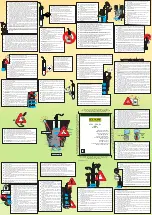
English (GB)
5
4.2 Booster systems for tank-filling applications
The booster system for tank-filling applications is designed to fill
a tank such as a roof tank or a break tank in a controlled manner.
The booster system controls the filling either via level switches or
a level sensor.
4.2.1 Operating principle
The system has two methods of operation, one based on level
switches and the other on a level sensor.
Operation with level switches
The user adjusts the switches in the tank to the desired stop and
start levels.
Operation with level sensor
The user adjusts the setpoint so it corresponds to the real tank
height, measured from the bottom of the tank to the top, via the
user interface of the CU 323 control unit.
Factory setting
Start level: 15 % of setpoint
Stop level: 85 % of setpoint
High-level alarm: 95 % of setpoint.
4.2.2 Control variants
The booster systems for tank-filling applications are available as control variants E and ES. Both systems work as described below.
Control variants E and ES
E: Two to four electronically speed-controlled pumps
ES: One to three mains-operated pumps and one speed-controlled pump
TM
05
02
22
09
11
Fig. 5
Example of control variant ES
• In tank-filling applications, the booster system fills the tank with focus on protecting the piping and preventing water hammer.
When low level in the tank is reached, a speed-controlled pump starts by running approximately 70 % of maximum speed in order
to slowly and safely fill the pipes. After a while, it increases the speed to 100 %, and the next pump is started. When the tank is full,
the pumps stop.
• Systems with more than two pumps will as default set one pump as standby pump.
• Changeover among the mains-operated pumps is automatic and depends on load, time and fault.
E-pump starts
fixed-speed pump
starts
fixed-speed pump
stops
E-pump stops
Time
Pump speed
t
n
100 %
70 %






































